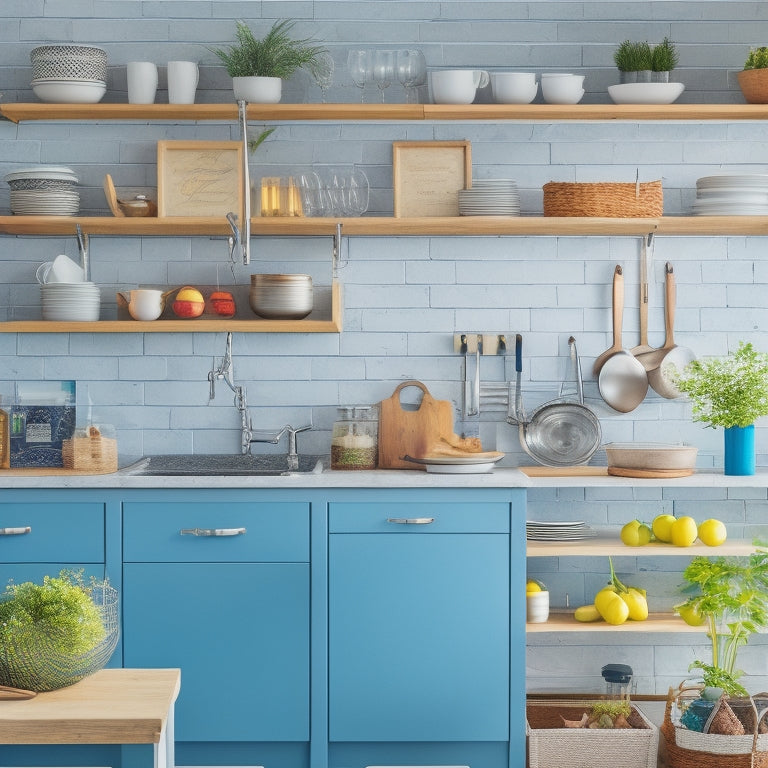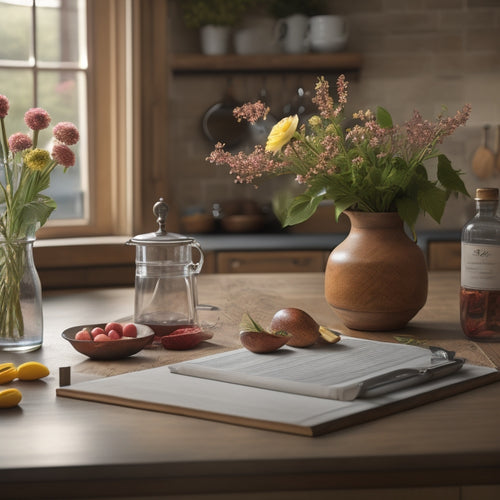
Couples' Kitchen Harmony: 7 Essential Organization Tips
Share
To create a harmonious kitchen with your partner, start by purging and decluttering together, setting a date to tackle emotional attachments and creating a 'maybe' box. Next, designate zones for efficiency, identifying cooking paths and assigning tasks based on habits. Optimize cabinet storage with custom inserts and adjustable shelves, and streamline countertop clutter by categorizing items and establishing a hierarchy. Label and sign everything, and create a meal planning station to promote efficient meal prep. Finally, schedule regular kitchen maintenance to guarantee a clutter-free space. By implementing these essential organization tips, you'll be well on your way to a stress-free kitchen that sparks joy and connection.
Key Takeaways
• Purge and declutter the kitchen together, addressing emotional attachments and being honest about necessary items to create a harmonious space.
• Designate zones for efficiency by identifying cooking paths, assigning tasks based on habits, and implementing the 'golden triangle' to reduce stress.
• Optimize cabinet storage by using custom inserts, adjustable shelves, and storing heavy items on lower shelves to maximize storage and prevent frustration.
• Streamline countertop clutter by categorizing items, establishing a hierarchy, and applying clutter psychology to reduce hazards and promote a peaceful environment.
• Label and sign everything, creating specific zones, and maintaining a harmonious environment to reduce chaos and hazards effectively.
Purge and Declutter Together
What's hiding in your kitchen that's causing clutter and chaos, and are you and your partner ready to tackle it together? It's time to purge and declutter your kitchen, and it's essential to do it as a team.
Start by setting a date and committing to it. This joint effort will help you both understand each other's communication styles and work together effectively.
As you begin, be aware of your emotional attachment to certain items. It's easy to get sentimental about grandma's old cookbook or the KitchenAid mixer you received as a wedding gift. However, if you haven't used it in the past year, it's likely taking up valuable space.
Create a 'maybe' box for items you're unsure about, and set a deadline to revisit them. Be honest with each other about what's truly necessary and what's just taking up space.
Designate Zones for Efficiency
With your kitchen decluttered and purged, you're now ready to create a functional layout that streamlines meal prep and cooking by designating zones for efficiency. This means dividing your kitchen into distinct areas, each dedicated to a specific task, to improve workstation flow and reduce congestion.
Start by identifying your cooking paths - the routes you take when preparing a meal. Typically, these paths include the sink, stove, and fridge.
Assign tasks to each zone based on your cooking habits and the appliances you use most. For example, designate a zone near the sink for food prep, and another near the stove for cooking. Make sure each zone has ample counter space, storage, and necessary utensils.
Consider the 'golden triangle' concept, where your sink, stove, and fridge form the points of a triangle to minimize walking distances between tasks. By creating a logical workflow, you'll reduce stress, increase productivity, and make mealtime more enjoyable.
Optimize Cabinet Storage Space
By strategically assigning contents to each cabinet, you can access hidden storage space and maintain a clutter-free kitchen. This is especially important in shared kitchen spaces where disorganization can lead to frustration and accidents. To maximize storage, consider the following cabinet optimization strategies:
| Cabinet Type | Optimization Tip | Safety Benefit |
|---|---|---|
| Corner Cabinets | Install Custom Inserts to utilize dead space | Reduces strain from reaching and bending |
| Tall Cabinets | Use Adjustable Shelves to accommodate items of varying sizes | Prevents heavy items from falling and causing injury |
| Lower Cabinets | Store heavy items near the floor to prevent them from falling | Reduces risk of crushing injuries |
Streamline Countertop Clutter
To regain control of your kitchen's central workspace, start by categorizing countertop items into must-haves, occasional uses, and clutter culprits. This exercise will help you establish a Countertop Hierarchy, where essential items take precedence over less frequently used ones. Be honest with yourself - if you haven't used it in the past month, it's likely a clutter culprit.
Next, apply some Clutter Psychology: ask yourself why you're holding onto certain items. Is it because they're sentimental, or do they serve a purpose? Be ruthless - if it's not serving a purpose, consider letting it go.
Once you've purged your countertops, organize remaining items into zones. Designate areas for food prep, cooking, and storage to maintain a sense of order.
As you work to streamline your countertop clutter, keep safety in mind. A cluttered kitchen can be a hazardous one, with tripping hazards and fire hazards lurking around every corner. By creating a more streamlined space, you'll reduce the risk of accidents and make cooking a more enjoyable experience.
Label and Sign Everything
Now that you've streamlined your countertop clutter, it's time to create a kitchen where everything has its designated place and is easily identifiable. By labeling and signing everything, you'll guarantee that you and your partner can quickly find what you need, reducing stress and making meal prep a breeze.
To get started, let's explore three key areas:
kitchen zone designations,
labeling storage containers, and
clear shelf markings.
Kitchen Zone Designations
Designating specific zones in your kitchen and labeling them accordingly allows you to maintain a sense of organization and structure. By doing so, you'll create a harmonious cooking environment where you and your partner can work efficiently together. This concept is often referred to as "Zone Personalities," where each zone is tailored to a specific task or function.
| Zone | Description |
|---|---|
| Prep Zone | Dedicated area for food preparation, including chopping, slicing, and dicing |
| Cooking Zone | Area for cooking, including stovetop, oven, and microwave |
| Cleaning Zone | Designated space for cleaning and sanitizing utensils and surfaces |
| Storage Zone | Area for storing kitchen essentials, such as spices, oils, and cookbooks |
Efficiency Mapping is key to creating these zones. Take note of your cooking habits and identify the most frequently used areas. By strategically placing your zones, you'll reduce congestion and improve workflow. Remember to keep your zones flexible, as your cooking needs may change over time. By implementing Kitchen Zone Designations, you'll create a kitchen that's both functional and safe for you and your partner to enjoy.
Labeling Storage Containers
You'll guarantee effortless retrieval of kitchen essentials by labeling storage containers and signing everything, from spice racks to cookbook shelves. This simple yet effective strategy makes certain that you and your partner can quickly find what you need, reducing kitchen chaos and potential hazards.
Start by selecting storage containers made from durable, easy-to-clean materials like glass or BPA-free plastic. Next, assign a specific color code to each category of items, such as baking supplies or cooking utensils. Use labels and stickers to identify the contents of each container, and consider adding a brief description or expiration date if applicable.
For added visibility, use bold, contrasting colors to make labels stand out. By labeling and signing everything, you'll avoid the frustration of digging through cluttered shelves or cupboards, and minimize the risk of accidents caused by misplaced items.
With a well-organized kitchen, you'll be able to focus on cooking up a storm together, safely and efficiently.
Clear Shelf Markings
By extending the labeling system to your shelves, you're creating a visual map that helps you and your partner swiftly locate specific cookbooks, ingredients, or equipment. This is especially important in a shared kitchen space, where miscommunication can lead to frustration and wasted time. Clear shelf markings guarantee that you can find what you need at a glance, reducing the likelihood of accidents and mistakes.
Labeling your shelves also taps into the psychology of organization, where a sense of order and structure can calm the mind and reduce stress. When you can see exactly where everything is, you'll feel more in control and confident in your cooking.
Here are some benefits of clear shelf markings:
-
Reduced stress: No more frantic searches for that one ingredient or cookbook.
-
Increased productivity: You'll spend less time searching and more time cooking.
-
Improved safety: Clearly labeled shelves decrease the risk of accidents and mistakes.
- Better communication: You and your partner will be on the same page, literally!
Create a Meal Planning Station
Establish a meal planning station near your kitchen's hub to streamline meal prep and reduce morning chaos. This centralized spot will help you and your partner stay on the same page when it comes to meal planning, grocery shopping, and cooking.
Start by setting up a Recipe Binder, where you can store and organize your favorite recipes. This will make it easy to plan meals for the week and make certain you have all the necessary ingredients.
Next, create a designated spot for your Grocery Lists. This can be a whiteboard, chalkboard, or even a sticky note on the fridge. Having a clear and accessible list will prevent duplicate purchases and reduce food waste.
You can also use this space to keep track of pantry staples, expiration dates, and meal prep schedules. By having all this information in one place, you'll be able to plan and execute meals with ease, saving time and reducing stress in the kitchen.
Schedule Regular Kitchen Maintenance
Set a recurring reminder to tackle kitchen maintenance tasks, guaranteeing your culinary space remains clutter-free, hygienic, and functional. By doing so, you'll avoid the buildup of grime, dust, and bacteria that can compromise your health and the quality of your meals. Regular maintenance also helps prevent appliance breakdowns, reducing the risk of fires and electrical shocks.
To stay on top of kitchen maintenance, try these essential tasks:
-
Clean the oven and stove every 2-3 months to prevent grime buildup and reduce the risk of fires.
-
Wipe down refrigerator seals and handles monthly to prevent bacterial growth and maintain a hygienic environment.
-
Run a cleaning cycle on your dishwasher every 1-2 months to ensure it continues to sanitize dishes effectively.
- Check and replace worn-out kitchen utensils and tools to prevent accidents and injuries.
Frequently Asked Questions
How Do I Handle Disagreements Over Kitchen Organization Styles?
When disagreements over kitchen organization styles arise, you'll benefit from employing effective communication strategies, such as active listening and "I" statements, to resolve conflicts peacefully and find a compromise that works for both parties.
Can a Small Kitchen Still Be Efficiently Organized?
You can efficiently organize a small kitchen by utilizing space savers like wall-mounted shelves and corner optimization techniques, ensuring a clutter-free area that promotes safety and ease of movement while cooking.
Are There Any Eco-Friendly Kitchen Organization Products Available?
You'll find eco-friendly kitchen organization products made from sustainable materials, like bamboo and recycled plastic, that support zero waste goals. Look for brands prioritizing environmental responsibility, ensuring a safe and guilt-free kitchen setup.
How Often Should Kitchen Organization Systems Be Reassessed?
You should reassess your kitchen organization systems every 3-6 months, or when you experience lifestyle changes, to confirm they still meet your needs; a seasonal refresh can also be a great opportunity to re-evaluate and optimize your space.
Can Kitchen Organization Tips Be Applied to Other Areas of the Home?
You're wondering if kitchen organization tips can be applied elsewhere, and the answer is yes! As you venture into Home Expansion, you'll find that Space Optimization techniques can be seamlessly transferred to other areas, ensuring a harmonious and safe living environment.
Related Posts
-

10 Best Free Printable Kitchen Planner Templates
You're looking to whip your kitchen into shape with some free printable kitchen planner templates! You've come to the...
